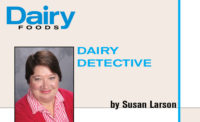Food and beverage formulators are always monitoring consumer trends. Incorporating sources of protein is one of the more popular trends, as evidenced by global protein product launch activity growing 14.5% from 2008 to 2012, according to Innova Database.
Dairy is uniquely positioned to provide high-quality protein, and the U.S. dairy industry is well-positioned to supply the global market. That much was evident at this year’s IFT Annual Meeting & Food Expo, where the U.S. Dairy Export Council (USDEC) debuted three prototype foods that help promote healthy aging and other benefits of higher-protein diets.
Protein in the adult diet
Recent studies show an estimated 30% of people older than 60 years and 50% of those older than 80 years may experience loss of muscle mass, function and strength. Further research shows diets higher in protein can help minimize muscle loss during aging.
“With our aging population, it’s been shown that high-protein diets in conjunction with resistance exercise are beneficial in slowing sarcopenia,” said Dr. Bryan Helwig, director of nutrition research at the Dairy Research Institute (established by America’s dairy farmers through the dairy checkoff program). “Sarcopenia, or age-associated muscle loss, begins at age 30 and is associated with a 3% to 8% loss of muscle mass per decade.”
The current recommended dietary allowance for protein intake in adults is 0.8 grams of protein per kilogram of body weight. Older individuals might benefit from consuming between 1 and 1.5 grams of protein per kilogram of body weight. Among protein choices, dairy proteins are ideal as they contain all the essential amino acids, including a high amount of leucine, an essential amino acid that stimulates muscle protein synthesis.
USDEC showcased a Veggie Burst beverage at IFT made from vegetable juices, milk minerals and high-quality dairy protein. U.S. whey protein isolate and milk minerals combine with vegetables to provide 24% and 30% of the daily recommended value of protein and calcium, respectively. This level of protein will improve strength, function and muscle mass.
Protein every day, all day
An important consideration for all age groups is consuming quality dairy proteins and spreading protein intake more evenly throughout the day. Recent research has indicated equal distribution of protein intake at breakfast, lunch and dinner results in enhanced muscle protein synthesis compared with a pattern in which most of the daily protein is consumed at dinner. In addition to helping build muscle, a higher-protein diet that includes dairy proteins has been associated with reducing measures of hunger, preserving lean body mass and promoting satiety (the feeling of fullness).
“Experts are now suggesting that it’s not just how much protein you get in an entire day that’s important, but also that you space that protein throughout all your meal occasions,” said Kara McDonald, director of U.S. ingredients marketing and communications for USDEC. “A general rule of thumb is to target around 30 grams of protein three times a day to really optimize that protein utilization by the body.”
One option for additional protein intake is Poutine-inspired Cheese Dippers, a snack introduced by USDEC at IFT. Milk protein concentrate, whey protein concentrate, nonfat/skim dry milk, whey permeate, butter and Juustoleipa cheese join other ingredients to offer a satisfying snack.
Not all proteins are created equal
U.S. dairy proteins are high-quality complete sources of protein that provide all the essential and nonessential amino acids. A growing body of research indicates dairy proteins containing whey stimulate muscle protein synthesis to a greater extent than plant- and legume-based protein sources.
The Protein Digestibility Corrected Amino Acid Score (PDCAAS) is the current method of measuring the quality of all proteins, including dairy-, plant- and legume-based proteins. It is limited in its ability to accurately calculate protein quality though. In a 2013 report, the FAO Expert Consultation recommended the Digestible Indispensable Amino Acid Score (DIAAS) as the protein calculation tool of choice.
Under the proposed change to DIAAS, protein quality scores for dairy products are estimated to increase. This will offer a more accurate reflection of the quality of dairy proteins compared with alternative protein sources. A research model to obtain digestibility values is currently ongoing. Once established, a database of digestibility values will be created for use in calculating DIAAS scores.
Visit www.InnovateWithDairy.com for more information on the value of U.S. dairy protein and the Veggie Burst and Poutine-inspired Cheese Dippers applications.




